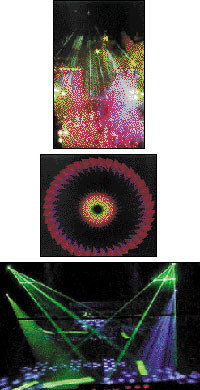
Achromatic Retarder Shows Its Colors in Laser Display
Daniel C. McCarthy
Although laser lab jocks might scoff at the comparative simplicity of technology used in laser light shows, the circumstances under which these instruments perform can be described as anything but laboratory conditions. Further, when a laser goes belly-up on the laboratory bench, the researcher doesn't have to contend with a stadium full of agitated spectators. Designers at Lighting Systems Design Inc., an integrator and manufacturer of laser displays, envisioned a more reliable system, and to turn their idea into reality they used a polymer-based achromatic retarder from Meadowlark Optics.

When the spectators filling the stadium get pumped up for a laser display, the show must go on, even if one laser fails. A polymeric achromatic retarder from Meadowlark Optics enabled Lighting Systems Design to develop a more reliable mixed-wavelength laser system.
"One worry is you'll take this instrument to the field and put it on a scaffolding at the end of a football stadium -- not lab conditions, in other words -- and in front of 20,000 people, they say 'go' and one of the lasers fails," said Greg Makhov, president of Lighting Systems Design. "Reliability is the No. 1 thing in equipment design, in both electronics and optics -- and efficiency. You have to make sure you can deliver most of the laser light. It's not unusual to have a 50 percent loss between the laser and projector. Ideally, we try to get 90 percent."
A beam to spare
Earlier systems produced by the company used dichroic filters to combine the red beam from a 647-nm krypton laser with the blue-green beam from a 488-nm argon-ion laser. If the krypton laser failed, the show could limp along with only one color, Makhov said. However, if the argon laser failed, the system output would drop to 5 W of red energy and the show would grind to a halt.
The company considered a mixed-gas laser design combining two gases in a single tube that would produce two white beams. A polychromatic acousto-optic modulator would manipulate the color for display. The design not only promised a more intense beam, but also incorporated a built-in fail-safe if one laser should fail. The challenge then became combining two oppositely polarized beams of the same color. "We needed to transmit one beam and reflect the other, therefore superimposing the two," Makhov explained.
One way to achieve this was a Fresnel rhomb, but this reduced the portability of the laser display and increased its overall cost. Achromatic retarders, the alternative, are generally made from cheaper and smaller mica or quartz elements. But both materials are wavelength-specific, which precluded their use with mixed-wavelength lasers.
Meadowlark's retarders, constructed from aligned birefringent polymer sheets, offered the solution. "They're flat over our design spectrum," Makhov said. That means that, unlike mica or quartz, they don't have a color-dependent characteristic. "They'll work across eight different wavelengths we use, from 647-nm krypton to 457-nm argon. We couldn't get a standard quartz retarder to do all that simultaneously."
Published: September 1999